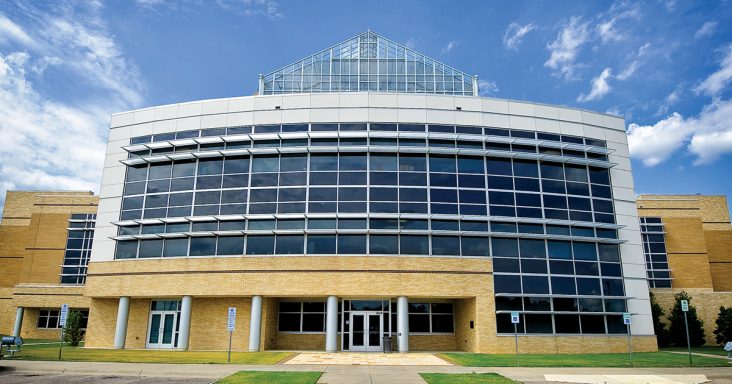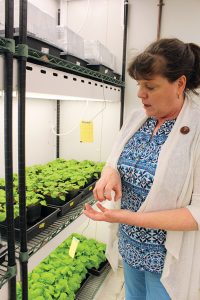CRISPR work leading to new medicines, agri improvements
by October 6, 2018 10:06 am 1,192 views

The Arkansas Biosciences Institute at Arkansas State University
Scientists in Arkansas and around the world are “like kids in a candy store” because the gene-editing technology “CRISPR” has become “a game-changer for medicine, agriculture and the environment,” said Dr. Maureen Dolan, one of those scientists.
Dolan is an associate professor of biological sciences at Arkansas State University and director of the biotechnology program at the Arkansas Biosciences Institute (ABI) at ASU.
The idea behind the CRISPR technology, Dolan said, is precision engineering of the genetic code. Two scientists at the Arkansas Biosciences Institute at ASU, Dr. Carole Cramer and Dr. Jianfeng Xu, are using the technology in their research intended to improve the health of the people of the state.
Around 2010, Dolan said, studies at universities on the East and West coasts in the United States first realized CRISPR “could be a new gene editing technology.” In 2012, researchers at the University of California at Berkley were the first to publish a paper showing the bacterial mechanism known as CRISPR could be used to finesse changes in the genetic code of an organism. Dolan calls this a “cut and paste” technique that results in swapping in a desired trait or eliminating an undesirable trait.
The technology with the catchy acronym and the long name — Clustered Regularly-Interspaced Short Palindromic Repeats — is significantly different from genetic modification, Dolan said.
“In its most straightforward application, CRISPR does not introduce DNA code of another organism into the host/target,” she said. CRISPR is more like traditional breeding, Dolan said. “You’re not adding anything new.”

Some scientists liken CRISPR to a “find and replace function” for DNA. Scientists design a short sequence of genetic code called guide RNA that matches the code they wish to replace in the host. They then attach the guide RNA to a protein called CAS9, which roams the cells until it finds the matching piece of code. Normally, CRISPR/CAS9 makes a cut through both strands of the DNA that matches the target, Dolan explained.
“Cells don’t like raw DNA termini,” she said, so they grab whatever other DNA is nearby and stitch the bits together, often imperfectly. Genes are “read” by the cell in three-letter chunks so CRISPR can eliminate just one block so the target gene no longer functions correctly and is effectively knocked out.
“It cuts out the error and sticks in the correct code,” Dolan said.
ASU is one of five member institutions of the ABI, created as the major research component of the Tobacco Settlement Proceeds Act of 2000. Scientists from the five member campuses — ASU-Jonesboro, Arkansas Children’s, the University of Arkansas-Division of Agriculture, the University of Arkansas at Fayetteville and the University of Arkansas for Medical Sciences — focus on agriculture and basic and clinical science research that leads to health improvements, especially in the area of tobacco-related diseases.
Faculty within the Biosciences Institute are encouraged to engage in entrepreneurial activities including spin-off companies, joint ventures and other business relationships to facilitate technology transfer and regional economic development.
Cramer, who retired from ASU in June 2018 and is now full-time with her own company, BioStrategies LC, used CRISPR a couple of years ago to create a diseased human cell line to test BioStrategies’ plant-produced protein therapy. Cramer was the first scientist in the ABI at ASU to adopt CRISPR technology, Dolan noted.
Xu is using CRISPR to “tweak” tobacco plants and cells to become even better “factories” for producing plant-made protein therapies, Dolan said. This is of use to BioStrategies, Dolan Lab, Xu Lab and others who are using the tobacco plant platform to produce human and animal protein therapeutics.
Dolan’s group is focused on aquaculture and is using plants as a platform for making an alternative to antibiotics to maintain fish health. She has worked with the University of Arkansas at Pine Bluff and the United States Department of Agriculture in those efforts. Dolan believes agriculture may be the place where widespread use of CRISPR technology first appears. Examples include producing seedless tomatoes, produce that is more shelf-stable, producing leaner piglets for healthier foods and producing larger quantities of foods for a growing world population without significant increase in land use.
Though improving agriculture through CRISPR may literally be “the low-hanging fruit,” Dolan sees the potential for CRISPR to have myriad applications in medicine including to modify HPV, the human papillomavirus that can cause a number of cancers. Uses could also include early diagnosis and personalized medicine tools and correcting genetic diseases such as muscular dystrophy or cystic fibrosis at the source.
CRISPR also has the potential to help scientists preserve resources and protect the environment, Dolan said.
It is paramount as work with CRISPR technology progresses, Dolan said, “that we as scientists … have a conversation that talks about this technology, that is open and transparent and builds public trust” in order to avoid some of the mistakes that were made with genetically modified organisms (GMOs).
